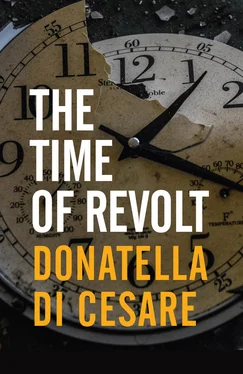But why occupy squares, specifically? Why not factories, or even universities – where occupations were commonplace even just a few years ago, but are now increasingly rare?
This turn from the factory to the public square ought not to be seen as a mere twist of fate, a trivial question of the logistics of protest. The idea that has inspired and oriented the workers’ movement throughout its momentous history holds that labour constitutes a world in common, even if it is alienated in market relations and vampirized in state structures. It is a community because of its horizontal structure and its place within a system of production and exchange which could keep going even without hierarchies, bosses and owners. This movement’s vision of the future held that the relations mediated by the abstraction of money and the commodity would eventually be overcome, as the relations between producers were redeemed and finally made human. Such a vision underpinned and fed the development of the various currents of trade unionism, socialism and anarchism. Hence the conception and the modality of a struggle understood as the final seizure of power by the collective worker.
Something similar can be said of the school and university occupations that punctuated the various phases of the student movement, in its different forms, from the 1960s onwards, peaking in the 1970s. These occupations were also coloured by a deep-seated, robust conviction that the world to come was already within reach – only a night of waiting away.
This fervour, this nervous expectation, this hope, has now all but vanished. The sentiments and the aspirations that pervade and agitate the squares today are rather more mixed, more complex, more contradictory. Occupations have left the factories and workplaces behind and largely also the universities, schools, and all the sites where social functions are performed – so many strategic hubs where it had once been possible for forces in conflict to come together. This turn has a clear political significance: it amounts to a recognition that, in the age of advanced capitalism, global debt, outsourced industries and growing precarity, labour no longer constitutes a community. Or, better, work is just the way in which each person involved in a merciless competition manages their own ‘human capital’. Moreover, as biopolitics teaches, today the whole of human life, and not just labour power alone, is summoned into use and cannibalized. This marks a decisive difference from the protests of the past and from such traditional forms of struggle as the strike.
Community can no longer be presupposed, only aspired to and sought out with great difficulty. Now that workplaces have been cast out of the topography of visibility, community has to be staged elsewhere; it has to be represented at some distance from the great palaces earmarked as the sites of representation. This also helps to explain the role of the assembly, where the other people – that is, the unrepresented people – must find their place. The new assemblies are attempts at community. Yet the aspiration that guides them seems to go no further than the gratification of being together.
The gathering plays out in the square, a space left empty by politics. It is, at the same time, a symbolic reference to the agorá , the first site of democracy and the last reserve available to community. This helps explain the mixing of resignation and resistance that takes place there. Being together means reacting against a world that isolates and separates. This is an ethical as well as a political response. In this sense, the occupation itself is already opposition. In the square, different forms of mobilization converge, from feminists to human rights activists, from environmentalists to the defenders of migrants, and from pacifists to antiracists. Nonetheless, this convergence is often only a temporary adding together of single struggles, and they do not manage to establish connections with one another.
With party slogans no longer able to appeal to the masses, the square is the theatre of invention – comics and actors are thus often present. Here, new gestures are devised, unprecedented and spectacular actions are experimented with, creative slogans are launched, and irreverent wordplay appears on placards and banners. But when the final notes of the collective chant of resistance die out, from one square to another the only apparent echo is the sharp ‘no’ of a global refusal of the global world.
An assertion of democracy and a practical show of solidarity, the squares movement risks dissipating amidst myriad particular struggles – or even being reintegrated by the agenda of official politics. It does not exert lasting influence, does not go beyond dissent, does not seem to leave a mark on the partition of the city which – as was apparent already in Plato’s studies – turns out to be justice itself. When workers went on strike, this did not involve only an occupation of the factories but also a subversion and redistribution of spaces. But, while the squares movement tries to react against the dispersion brought by capitalism, it does not manage to reconfigure the public space.
Конец ознакомительного фрагмента.
Текст предоставлен ООО «ЛитРес».
Прочитайте эту книгу целиком, купив полную легальную версию на ЛитРес.
Безопасно оплатить книгу можно банковской картой Visa, MasterCard, Maestro, со счета мобильного телефона, с платежного терминала, в салоне МТС или Связной, через PayPal, WebMoney, Яндекс.Деньги, QIWI Кошелек, бонусными картами или другим удобным Вам способом.












